Painting Miniatures - You Can Do It Too!
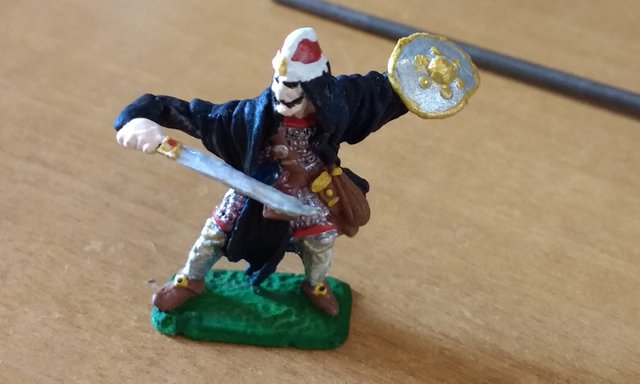
The best tip I could give to someone that wants to start painting their minis is this:
JUST DO IT
I know what you're thinking
- B-but if I mess up I'll lose my mini!
- I don't have a complete set of Citadel paint!
- Priming? Drybrushing? Washes? Flocking? This sounds too complicated!
- I'll never be as good as the pros!
And how do I know? Because I thought the exact same things (or excuses) before I just took the plunge and started painting my old minis.
I'm clearly not the most qualified person to teach you how to paint minis, there's dozens of better tutorials a google search away, and YouTube is also a great resource, the WIP (work-in-progress) thread on 4chan's own /tg/ is usually great and has a very positive vibe (considering it's 4chan, that is).
But what I can do is help your overcome the aforementioned fears.
If I Mess Up I'll Lose my Mini
No you won't, most times you can just re-prime it or strip the pain off with some Simple Green or Purple Power (follow this guide).
Since re-priming is much easier, when starting out pick minis with little to no fine detail, as those can be lost if you apply too thick a coat and then re-prime them.
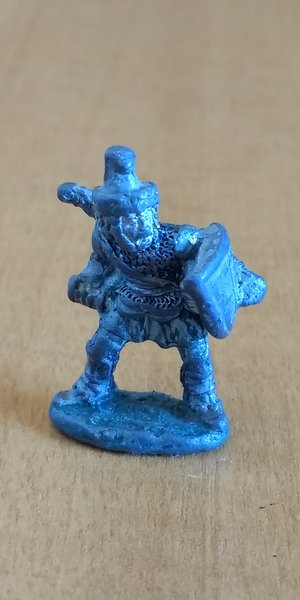
Mini freshly stripped, you can see not everything comes off but that's not a problem
I Don't Have the Right Paints
When I got back into painting minis, I used a 15 years old acrylic paint set meant for canvas, it taught me many lessons and none of them was "give up".
Don't get me wrong, having a nice assortment of different colors at the right thickness helps a lot, but in my case that wasn't an option, I can't get a "real" mini painting set where I live, so I just made do with what I got.
It turned out ok... I ended up stripping the model and repainting it when I bought new paints (again, meant for canvas).

Did I say 15 years? I meant 20+...
Priming, Drybrushing, Washes and Flocking
If you search online for "how do I into mini painting" you will find a lot discussion around these techniques, which make them seem daunting at first, here's my take on them as well as rough order in which you should bother trying your first crack at:
- Priming
It's really the first thing you should master, while some figures take paint well unprimed (meaning the paint actually sticks to the piece) most won't, so you'll want to prime your minis before painting them.
Pick a can of a solid color matte spray, any brand really. I find white to be easier to learn with since you'll see the colors pop much more when painting. Then get on a well ventilated area, protect the surrounding surface, and go around the model doing quick 1-2 second bursts at a minimum distance of 30cm (1ft), wait 10-20 minutes and do it again, wait, and make a third pass if you like.
That's it. Now wait a couple of hours or so to pick up your mini and start actually painting! If it feels sticky just wait more (hint: you might have held the trigger too long or the can too close if this happens)
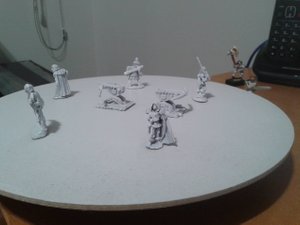
Or use a turntable... made from scrap bearings and a MDF disk
- Drybrushing
Drybrushing is literally what it sounds like, taking a dry brush and brushing it on your piece. It is the easiest method of highlighting, which is putting lighter tones on surfaces that would be more exposed to light on a model. It emphasizes the behavior of light and makes the model pop.
To drybrush correctly, first make sure that the paint on the surface you're about to work on is dry, then you take a relatively stiff brush (or any brush you have), wet it a bit on paint and then brush it across some scrap paper to remove most of the paint, once you're almost not staining the paper anymore you just brush the surface.
You will be amazed with how much better your model will look, even on your first try.
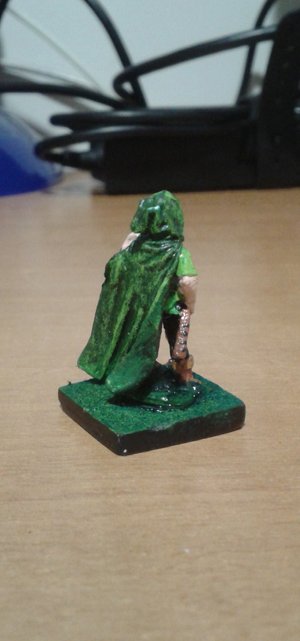
The lighter green on the cape was drybrushed in
- Washes
A wash is little more than a very diluted down paint, you coat the spots you want to emphasize shadows (mostly) and put down the wash, since it's very thin it'll just pool inside the little crevices and darken them, enhancing the 3d look. In a way it's the polar opposite of highlighting.
For a complete beginner, I didn't bother with washes until I had painted about 5-6 models, it's really something that takes your painting to the next level but absolutely not mandatory to mess with on your first model.
Black Magic Craft on YouTube has a very easy-to-follow video on how to make your own wash (link)
If you ever wondered "how did these people painted those tiny little holes in this miniature's chainlinks", the answer is: They didn't ;) - Flocking
If you ask Wikipedia you'll get "Flocking is the process of depositing many small fiber particles (called flock) onto a surface."
It is mostly used by wargamers to simulate grassy areas, with special attention to texture. Simply put, it is very hard to create the grass feel with just a flat paint job, you need texture underneath to apply highlights and give the variation needed for a truly natural look.
In miniature painting it's sees more uses at the base of the model, which is very much part of the model and should be treated as such, but it's not mandatory and you can be very successful not bothering with it until you feel that creative itch.
TheDMGInfo at YouTube has a tutorial on how to make your own flocking for dirt cheap (link). I made mine using sawdust I collect from other projects and some drops of alcohol-activated aniline.
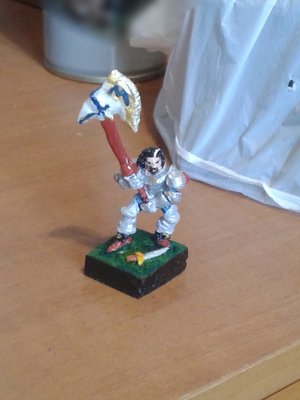
The grass at the base is painted sawdust with lighter green drybrushed
I'll Never Be as Good as the Pros!
You're probably right, but that's the wrong mindset. You should be worrying about being better than yourself, this is supposed to be fun and looking at other people's work should be an inspiration to strive and get better, not a yardstick to dwarf your accomplishments.
With the pep talk done, I might also add that if you plan on using these at the game table, you're going to be looking at them from a considerable distance, and the mistakes will definitely blend in and disappear, leaving you with a much better looking figure for and epic feel.
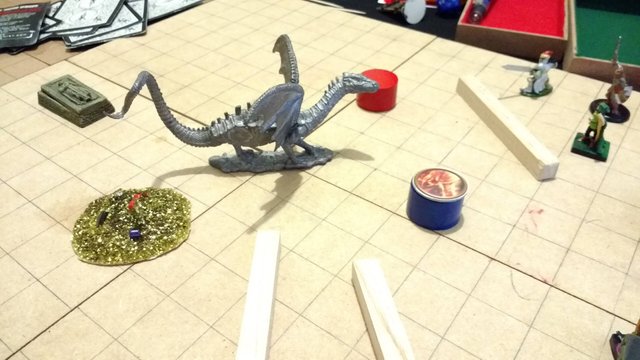
How's that for an epic feel?
Awesome quick start guide, and "just do it!" is great advice for getting in to almost any hobby. I still haven't painted any minis (almost all of the minis I have are of the pre-painted plastic variety) but if I can find my old HeroQuest game at my parent's house I will have a bunch of unpainted minis to try my hand at. In particular I am thinking about painting up a bunch of the skeletons as the D&D campaign I am running seems to be heading in a very undead direction. :)
Yeah the just do it attitude is essential!
At first you suck (like anything you do for the first time) but then it gets better, if you focus on where you're going it doesn't really matter too much where you are right now.
If you're painting skeletons I'd suggest getting some two-part epoxy and make little pieces for them, just to make them different (a helmet, shin guards, one-sided spaulders) that way you have more places to use paint other than "whitish beige".
Incredibly detailed, very impressive!
Thanks for the kind words!
I mused about making it a mini-series post but multi-part really doesn't go well with it's easy, you can do it!
I think I struck a fair balance between simplicity and thoroughness.
Next up I'll paint a 3d printed model, a friend of mine printed it on a home machine, so it's not ultra-detailed like the ones from HeroForge or ordered from Shapeways, should be fun :)
Congratulations! This post has been upvoted from the communal account, @minnowsupport, by anonvt from the Minnow Support Project. It's a witness project run by aggroed, ausbitbank, teamsteem, theprophet0, and someguy123. The goal is to help Steemit grow by supporting Minnows and creating a social network. Please find us in the Peace, Abundance, and Liberty Network (PALnet) Discord Channel. It's a completely public and open space to all members of the Steemit community who voluntarily choose to be there.
If you like what we're doing please upvote this comment so we can continue to build the community account that's supporting all members.
The last time I painted a miniature model, I completely botched it. That being said, it was still a fun experience. Thanks for the motivation!